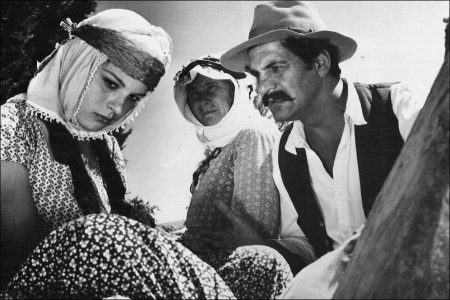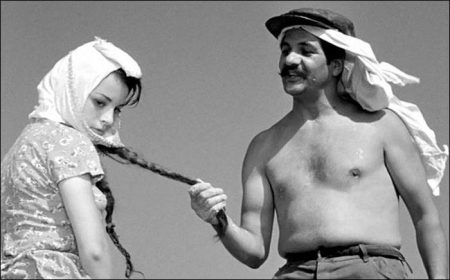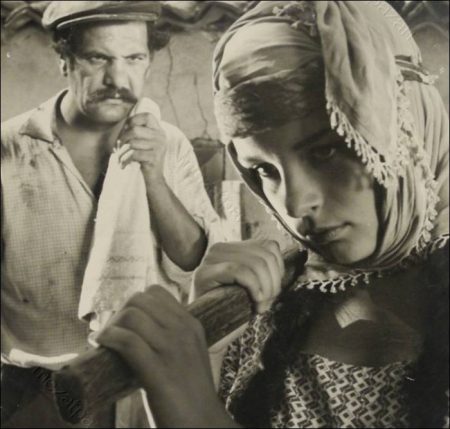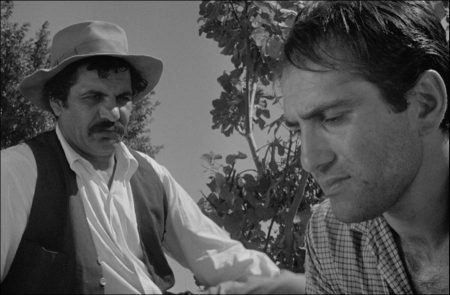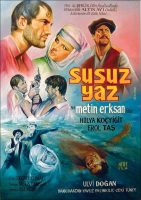Dry Summer – Susuz Yaz movie storyline. Osman decides to dam the spring on his property because he knows the summer will be too dry to support all the farmers who rely on its waters. His younger brother Hasan urges him not to dam the spring, but reluctantly goes along with him. The farmers are furious with Osman. They initiate a legal dispute. Osman is ordered to keep the spring open while the dispute is being resolved, but he disobeys this order. Hasan occasionally opens the dam out of pity for his neighbors, but Osman is quick to close it again.
Meanwhile, Hasan courts and marries a young woman named Bahar. On their wedding night, Osman bursts into their bedroom and orders Bahar to breed as many as 10 children for the family. Hasan has to put a dresser in front of the window to block out his drunken brother. Osman finds a crack in the wall and watches the consummation.
One of the farmers kills Osman’s dog, prompting the brothers to keep watch at night to prevent further violence. That night, two farmers blow up the dam. Osman and Hasan chase the saboteurs. Osman fires several shots into the darkness, killing one of the farmers. He convinces Hasan to take the blame for the killing by arguing that Hasan is much younger and will get a lighter sentence.
Hasan is sentenced to 24 years, which is reduced to 8 because he was provoked. Osman uses his absence to advance on Bahar. He destroys Hasan’s letters to make it appear as if he has forgotten Bahar. When a prisoner named Hasan is killed in the same prison as her husband, Bahar is distraught. She flees the farm and returns to her mother. Osman convinces her to return by explaining that, as Hasan’s widow, she owns half of everything.
Dry Summer (a.k.a. Reflections; Turkish: Susuz Yaz) is a 1964 black-and-white Turkish drama film, co-produced, co-written and directed by Metin Erksan based on a novel by Necati Cumalı, featuring Erol Taş as a tobacco farmer, who dams a river to irrigate his own property and ruin his competitors. It is also available in an English dubbed U.S. theatrical release titled Reflections produced by William Shelton and edited by David E. Durston.
Dry Summer helped introduce Turkish cinema to a global audience. It continues a theme of possessiveness that Eksan had previously explored in Revenge of the Snakes. The film was censured by the Ministry of Interior’s film censorship board which objected to Bahar’s implied union with her dead husband’s brother. The film was banned for fear of broadcasting negative images of Turkish society.
There are two instances of animal cruelty in the film, when Osman slaughters a chicken and when one of the villagers kills Osman’s dog. The film won the Golden Bear at the 14th Berlin International Film Festival and the Biennale Award at the 25th Venice Film Festival. The film was also selected as the Turkish entry for the Best Foreign Language Film at the 37th Academy Awards, but was not accepted as a nominee.
Film Review for Dry Summer
When Dry Summer won the Golden Bear at the 1964 Berlin Film Festival, its director, Metin Erksan, was already among the biggest names in Turkish cinema. One would have thought that after the award—not just the first major international one given to a Turkish film but arguably the highest honor given to any cultural product from Turkey until then—he would become one of his country’s foremost artistic figures. But while the win was momentous, the ground beneath Erksan and his industry was already shifting. Dry Summer was, in many ways, the surprising, abrupt end of an incomplete chapter in the nation’s film history.
Although various films were made in Turkey throughout the early twentieth century, a self-sustaining and stable industry didn’t take hold until 1948, when the government introduced a 50 percent tax cut for theaters showing domestic films. The resulting boom in production enabled a new generation of filmmakers to breathe life into a cinema whose aesthetic to that point had been frustratingly stage-bound, even as they struggled with many of the same limitations as their forebears (prehistoric equipment, unforgiving schedules, overzealous censors).
Among the directors in this new wave, a small group stood out for their more cinematically sophisticated works. Starting in the early 1950s, headstrong directors like Erksan, Lutfi Akad (Strike the Whore, Port of Lonely Souls), and Atif Yilmaz (The Girl Who Watched the Mountain, This Land’s Children) sought to create more distinctly humanist and personal works, inspired in part by Italian neorealism.
Erksan had been one of Turkey’s first film critics in the early to mid-1940s and in 1952 directed his first feature, The Dark World, a biopic of the blind folk troubadour Asik Veysel. The film included numerous documentary scenes of the elderly musician himself—a docu-narrative hybrid avant la lettre. It also represented an early attempt to convey an authentic portrait of life in the impoverished Anatolian heartland, something Erksan would return to numerous times over his career. As such, it ran afoul of the authorities and was released only in a butchered version, thus marking the first of the director’s many confrontations with censor boards.
Most Turkish cinema during this period sought to mimic popular Egyptian melodramas and American genre pictures. Respected auteurs like Erksan and Akad made their share of such films too. But they also attempted to connect more with the lives of average citizens in a rapidly modernizing country, still deeply divided along cultural, economic, and geographic lines.
Erksan’s 1960 film Beyond the Nights, for example, was a crime drama about a group of wayward friends planning a robbery, but it emphasized the hopes and fears of its troubled, rootless protagonists over the story’s typical policier elements. His 1962 adaptation of Fakir Baykurt’s novel of a rural land dispute, Revenge of the Snakes, again ran into trouble with censors—until, amazingly, Turkish president Cemal Gürsel intervened, deeming the work “a service to the nation” and noting that its depiction of the harsh realities of village life was not only accurate but underplayed.
Revenge of the Snakes had been a look at the corrosive nature of property, focused on the land. Now Erksan wanted to follow that up with a similar tale focused on water. He had written his own story around this theme but abandoned it in favor of Dry Summer, an adaptation of Necati Cumalı’s novella of the same name. (Several years later, the director would complete this unofficial trilogy with The Well, about the treatment of women as property.)
After films like The Dark World and Revenge of the Snakes, with Dry Summer Erksan wanted to create an even more faithful depiction of rural life. This film would be far more ambitious, made outside of Turkey’s traditional production houses. Financed personally by producer Ulvi Doğan, who also played the young romantic lead Hasan, the film reportedly shot for nine months, on location in the Aegean town where Cumalı had once served as an attorney.
The production even used real villagers as extras, some of whom claimed to have witnessed the events that inspired Cumalı’s story. Adding to the realism were the voices of the rural characters in the film. Turkey is a nation with a staggeringly broad range of dialects and vocal inflections, but for decades, characters in films spoke proper Istanbul Turkish—even if the films took place in remote Anatolian villages. In Dry Summer, however, the characters speak with Aegean accents. (This was a departure from the novella as well.)
But perhaps more importantly, Dry Summer evinces Erksan’s feel for the textures of rural life—its monotony, sensuousness, and violence. The film opens on repeated shots of Osman (Erol Taş) and his two mules making their way through the streets of his village—six shots in a row of basically the same thing. This odd, willful repetition is echoed at the end, when we get repeated shots of Osman’s dead body floating down the spring he sought to control. It’s a frame that places the events of the film within the rhythms of the countryside, lending it the quality of a fable.
The characters in Dry Summer are extensions of the natural world around them. Osman’s decision to block the spring that runs from his and his brother Hasan’s land to the neighboring farms below is seen by his fellow villagers as an act of violence against the earth. “Water is the earth’s blood!” they repeatedly protest. Hence the heavily symbolic ending, in which Hasan repeatedly rises out of the water as he approaches and finally overwhelms his brother, as if the very water is taking revenge on Osman. Similarly, an early romantic exchange between Hasan and his lover, Bahar (Hülya Koçyiğit), takes place in a thicket of tall reeds—groping and grasping in the dark, the two might as well be creatures of the earth giving way to their most natural impulses. This was an earthiness, a forthright animal magnetism, rarely found in the urbane Turkish cinema of the 1960s.
With a kind of dark, subtle wit, Erksan contrasts the raging passions of the main characters—Hasan’s for Bahar, and Osman’s for, first, the water and his land and, later, also for Bahar—with the powerlessness of the authorities and elites. The local officials who get involved in the water dispute force Osman to make his water available to the other villagers. But further legal recourse results in the same authorities standing over Osman again as, just a little while later, he closes the water supply off.
Similarly, after he goes to prison, Hasan is seen chatting with a fellow inmate named Kamel, who lectures him about the importance of “legal technique” and seems to want to awaken our hero’s class consciousness. Coded as an intellectual—he’s reading a paper, wearing a vest and glasses, and smoking with a cigarette holder—this refined, bookish older man seems like a typical directorial stand-in, a voice of reason who argues against impulsive violence and for unified, organized action. But such ideas go out the window as soon as Hasan returns to his village.
Alongside Dry Summer’s “realist” virtues, the film also displays some of the more idiosyncratic qualities of Erksan’s cinema. In fact, today the film is more notable for the bizarre, stylized avenues down which it pursues its villain’s gathering madness. Obsession had always been a key theme in Erksan’s work, but this film becomes downright surreal as Osman is consumed by lust for his brother’s wife—watching her, groping her, coming on to her, and, at one point, proposing to a scarecrow that he pretends is her.
One can sense the film’s fascinating, uneasy truce between its more naturalistic qualities and these outré elements during the scene where Osman, milking a cow in Bahar’s presence, begins suggestively sucking on the animal’s teat, a moment of typical “village realism” transformed into a wild, comic grotesque. (Here we must also give credit to Erol Taş, who would become one of the great heavies of Turkish cinema, notorious for his portrayal of imperious landowners, gangsters, murderers, even Mexican bandits, and, in one series, a mad scientist named Dr. Satan.)
Erksan’s films would take on an increasingly perverse quality in the ensuing years: In his 1964 noir The Guilty Are Among Us, he stages the film’s climax during a posh gala where all the guests wear scuba-diving outfits. The following year’s Time to Love is a symbolic, absurdist romance about a man who falls in love with a woman’s portrait, forsaking the woman herself. Female Hamlet (1977) is a modernized version of Shakespeare’s tragedy, full of wildly surreal, comic passages depicting Hamlet’s outward madness; the film seems to reflect its protagonist’s pretend lunacy, veering between comedy, musical, and Peckinpah-influenced slow-motion bloodfest.
Dry Summer’s combination of such sensuous outlandishness with more social realist qualities resulted in its also running into trouble with the government, which didn’t want a film depicting life in the Turkish heartland as tragic and boiling over with lust screened abroad. But producer Doğan reportedly smuggled the negative into Germany in the trunk of a car, and after the film won the Golden Bear, the authorities softened their stance.
In his memoirs, the director Lutfi Akad relates how his film The White Handkerchief (1955) was directly affected: Initially, Akad’s film was permitted to screen only under the condition that it not be shown outside Turkey. After Dry Summer’s Berlin win, the authorities decided that The White Handkerchief’s “being viewed abroad will have positive effects on Turkish cinema.” Dry Summer even led to some legal reforms, according to Erksan: previously, Turkish law had held that streams, rivers, and other waterways were public property but that springs could be privately owned; after Dry Summer, the law was revised to make springs public as well.
When news of the Berlin win came, the government organized the meeting of the first Turkish Cinema Council, inviting filmmakers, producers, exhibitors, and critics. However, as the director Halit Refiğ tells it, the gathering ended in argument and recrimination: exhibitors who wanted to show more foreign films made common cause with critics growing wary of domestic films, which they saw as inferior to Hollywood’s and those of the exciting new cinemas of Europe. What was supposed to be an event bringing the industry together and consolidating the recent strides of Turkish cinema wound up driving everyone apart.
Within a year, the battle lines would become even more stark, with the founding of the Turkish Cinematheque, an institution inspired by the Cinémathèque française and focused on bringing foreign films into the country. Its founders looked down on Turkish cinema as technically backward, aesthetically incompetent, and politically conservative. This was a particularly troubling development for Erksan, who had not only tried to spearhead a “national cinema” but had also proven his leftist bona fides in regular battles with government censors. Along the way, Dry Summer’s Berlin win began to seem less like a high point and more like a fluke. There was even a silly rumor that the film had won only because Erksan seduced one of the jury members, an Egyptian actress.
Unfortunately, domestic filmmakers had to live down the intelligentsia’s contempt for years. That the industry was moving increasingly toward cheaper, more vulgar product didn’t help. By the early 1970s, Turkey was churning out well over two hundred films a year, but the majority of these were porn flicks, and many of the rest were foreign knockoffs. (Even Erksan was forced to take some of these gigs: until the restoration of Dry Summer, the only one of his films to find any real audience abroad was Şeytan, his 1974 remake of William Friedkin’s The Exorcist, embraced in later years by cult audiences looking for an irony fix.)
Such developments also echoed Dry Summer’s fate, in an odd way. Although the authorities had been ready to welcome it with open arms after Berlin, the negative of the film never made it back from Germany, and for many years it was very difficult to see. Meanwhile, it was reportedly chopped up and distributed in the West (by Doğan) as a soft-core film titled My Brother’s Wife, with new scenes starring a Hülya Koçyiğit look-alike shot and added by others.
Embittered with the industry that he’d helped to shape, and resentful of critics, Erksan gradually withdrew from filmmaking. Aside from a TV miniseries in 1982, his last film was 1977’s Female Hamlet. In later years, he devoted himself to teaching and to writing books about politics and history. However, he lived long enough to learn of Dry Summer’s 2008 restoration by the Cineteca di Bologna and the World Cinema Project, and its renewed embrace by the international community. He also lived long enough to see his own countrymen rediscover the national cinema he had fought so long to forge— ironically, through the medium of television, where the films that he, Akad, Yilmaz, and others had fought to make in the fifties, sixties, and seventies found new life as classics, even for the intellectuals who had scorned them back in the day.
Erksan died in 2012. Akad had preceded him by a year, but not before writing these words about his friend and colleague, which could have served as a kind of epitaph: “He struggled on, repressing the pain of all the films he didn’t get to make . . . Under different circumstances, I have no doubt that he would have numbered among the great names of world cinema.”
Dry Summer – Susuz Yaz (1963)
Directed by: Metin Erksan
Starring: Hülya Koçyiğit, Erol Taş, Ercan Yazgan, Hakkı Haktan, Zeki Tüney, Alaattin Altıok, Niyazi Er, Ulvi Doğan, Alev Koral, Yavuz Yalınkılıç, Sadettin Erbil, Sami Ayanoğlu
Screenplay by: Metin Erksan, Kemal İnci, İsmet Soydan
Cinematography by: Ali Uğur
Film Editing by: Turgut İnangiray, Stuart Gellman
Music by: Ahmet Yamacı, Manos Hadjidakis
MPAA Rating: None.
Distributed by: Manson Distributing (USA)
Release Date: December 16, 1963
Views: 180
